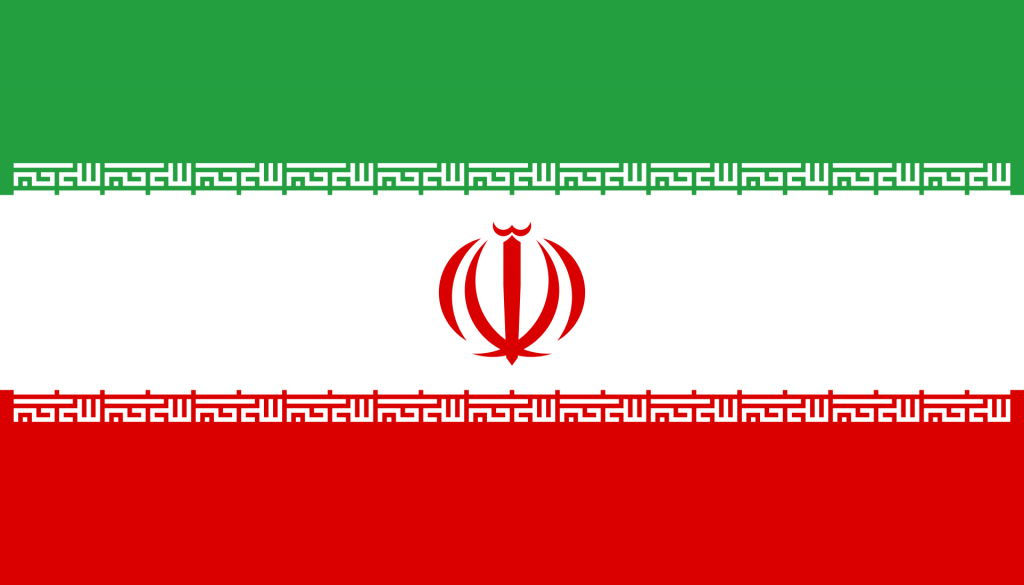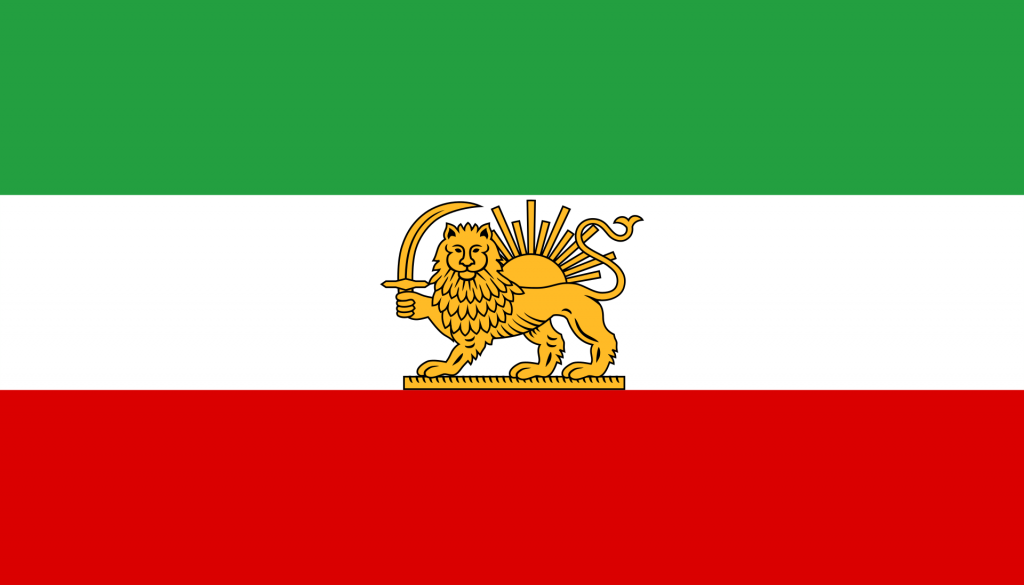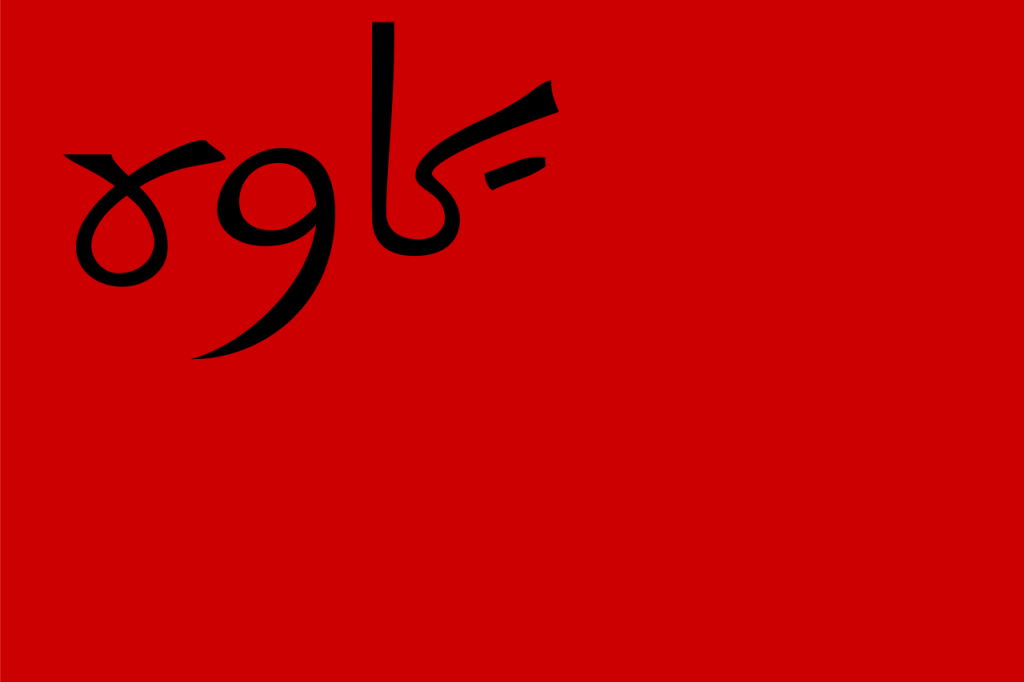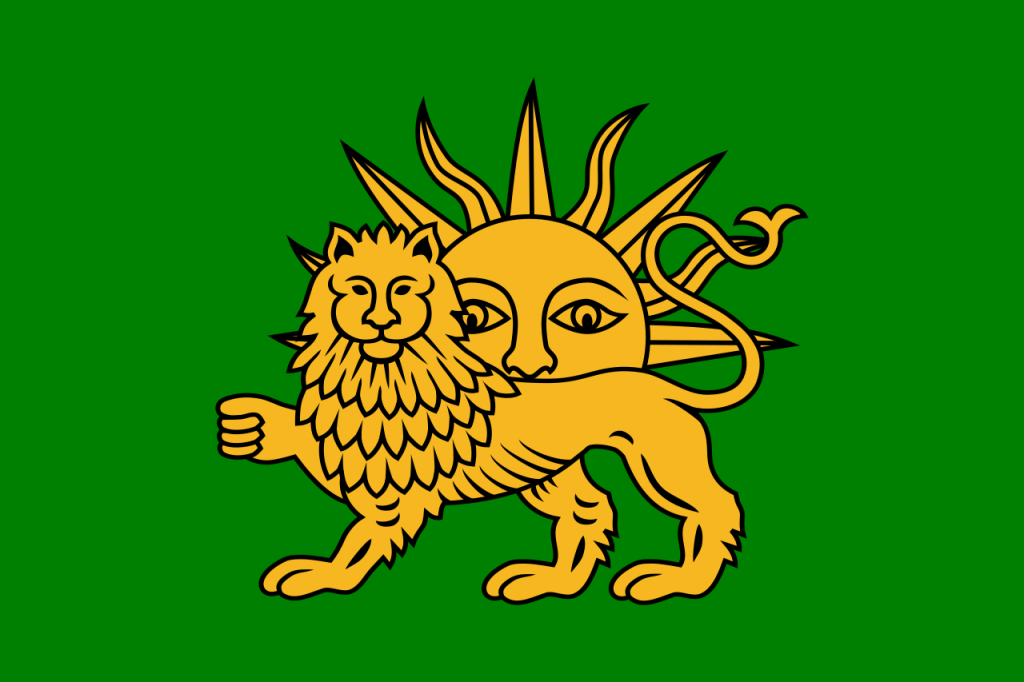The Islamic Republic of Iran is a country with history stretching back thousands of years, covering many different regimes, cultures and ideologies. It can be quite confusing to understand, but a good way to learn about a country is to look at its flag. The flag of Iran has had many variations over the years, each change marking a shift that tells us a little about how the state wishes to present itself to the world and themselves.
Flag of the Islamic Republic of Iran

This is the current flag of Iran. The flag currently flying in the streets of Tehran, atop government buildings and slapped on the uniforms of its military. A green-white-red tricolour with some strange patterns on the borders of the white and a red symbol in the middle. Let’s start off by focusing on the colours. These colours have been a feature of the Iranian flag since the 1800s, though their origins can be traced even earlier than that.
Red and white are easy. White is a symbol of peace, as it is often seen in many countries. Red meanwhile stands for courage or valour, another common piece of colour symbolism on flags across the world. As for the green… Traditionally, the colour green is associated with the Islamic faith and can be seen on the flags of many Islamic nations. The tomb of the prophet Muhammad was shrouded in a green dome and indeed, the Quran itself has passages which state that robes of green silk are worn in the afterlife.
Upon them will be green garments of fine silk and heavy brocade, and they will be adorned with bracelets of silver; and their Lord will give to them to drink of a Water Pure and Holy.
— Sura 76, verse 21.
So then, how about those patterns through the green and red? That’s actually script, repeated 22 times in reference to the Iranian revolution of 1979 taking place on 22 Bahrām in the Iranian calendar. The inscription reads “God is the greatest” otherwise known as ‘Allahu Akbar’. You might have seen this in our previous flag article about the flag of Iraq, where the same inscription is in the centre. But if you look at them… This text is very different to the Iraqi flag.
So what’s with the flag of Iran then, why is it so different? While both are written in Kufic script, the version on the Iranian flag is a particular form known as ‘Square Kufic’, which prioritizes the aesthetics and form of the letters over legibility. If you look carefully, the same basic principles as the Iraqi text are right there, just converted into this square, almost pixelized form. This script, indigenous to Iran, can be seen decorating a wide range of Iranian architecture too.
And lastly we come to the emblem. What does this represent for the flag of Iran? Designed by the artist Hamid Nadimi shortly after the Iranian revolution, the image is four curves surrounding a sword, but more than that, they are a stylized inscription of the word ‘Allah’. The five distinct portions are said to represent the five ‘Principles of faith’ in Twelver Shia theology, the primary Islamic sect in Iran. It would take too long to go into each of these in detail, but simply summarized, they are ‘oneness’ (monotheism), justice, prophethood, leadership and the day of resurrection. Lastly, the image quite simply resembles a tulip, which is said to commemorate the memory of those who died for Iran.
Flag of Iran – Pahlavi Dynasty

This flag may be very familiar to a lot of you too. If you live in a western country with a large Iranian diaspora or you’ve been to an anti-Iranian government protest, you might have seen this flag being openly waved even today. This was the Iranian flag pre-revolution, during the era of the Pahlavi Dynasty, otherwise known as the Imperial State of Iran. From 1925-1979, this was the flag that ruled the country in a system much different from what exists now.
So you’ll notice the three colours are unchanged. Evidently this was seen as a pure symbol of Iran after the revolution and there was no need to change it. What has changed is that the Kufic script is gone and the emblem has been replaced by a sword-wielding lion in front of a sun. While you might assume this is the imperial seal of the monarchy, its roots actually stretch back much further. The Lion and Sun has been a popular symbol since at least the 12th century, representing the sun in the astrological sign of Leo.
While originally an astrological symbol, it was later associated with Twelver Islam through the Safavid Dynasty who also used the symbol on their flag. Interpretations of the symbol have come and gone over the centuries, some religious and others nationalistic, allowing the emblem to symbolise many things to many people. Evidently in the eyes of the Ayatollah (as well as the eyes of the monarchy for that matter), the emblem was seen as a symbol of the Shah monarchy under the Pahlavi dynasty. In a post-revolution society, this symbol had to be cast aside, fundamentally changing the flag of Iran.
Flag of the Iranian Socialist Soviet Republic

That’s right, Iran has a history as a Soviet republic. Albeit very, very briefly. From June 1920 to September 1921, so only a little over a year. Its start came when a largely Islamic land-reformist movement called the Jungle Movement of Gilan waged an uprising in Gilan, which bordered the then Soviet Union. While their struggle was not Marxist and had seen little success for several years, anti-imperialist sentiment was rising in the movement and an influx of Marxists filled its ranks. This changed the character somewhat, but overall this was an Islamic and nationalist movement first and foremost.
Things changed in 1920 when a larger uprising was met with unexpected support from the Soviet Red Army, who upheld an alliance between the Jungle Movement and the Iranian Communist Party to form the Iranian Socialist Soviet Republic. Ultimately, its territory was only a fraction of Iran and almost immediately it was besieged by both the Iranian central government and the British. When the Soviets signed an agreement with the British to withdraw their troops, the short-lived socialist state collapsed and its leaders were driven out into the cold where they froze to death.
Anyway… This is about Iranian flags, not just history. You might notice a shared theme with the Soviet flag, that being the crimson red background coupled with an image in the top-left, in this case Persian script reading ‘Kaveh’ in reference to a mythological Iranian figure known as Kaveh the Blacksmith. Kaveh was a figure in the Shahmaneh, a historical epic poem of around 50,000 two-line verses written between 977-1010, blending mythology and history to tell the story of Iran. Kaveh was said to be a blacksmith who led a national uprising against a tyrannical foreign king, just perfect as the emblem for a socialist state.
Flag of the Safavid Dynasty

Now this is a very old Iranian flag. From all the way back in 1576 in fact! Before finally being retired in 1732, at which point the flag of Iran changed frequently but often retained the lion and sun symbolism. Speaking of, you might notice that this version of the flag has the exact same lion as before, albeit without a sword. This is where the symbol used all the way up until the start of the 1980s originates from, with the Safavid dynasty standing as a point of immense pride and prestige for the Iranian nation.
The Safavid dynasty at their peak controlled not only Iran, but held territory stretching through the Gulf into Bahrain and Kuwait, east into Afghanistan and Pakistan, north into the Caucasus region, west into Iraq and Syria, parts of Turkmenistan and Uzbekistan and even small parts of Russia. In its day, it was a major regional power that left its roots in much of the territory it conquered. Twelver Shia Islam, the state religion of Iran to this day, was developed there and can be found most prominently in its former territory.
For the Safavids, the lion and sun stood primarily for the twin powers of the state and religion. Often, the lion was considered a symbol of Ali, the caliph of the Rashidun Caliphate, companion of the prophet Muhammad and founder of Shia Islam. As for the sun, it was viewed as symbolic of the mythical founder of Iran, Jamshid, whose name partially translates as ‘shining’ or ‘radiant’. This lines up pretty well with the interpretation of state and religion united under the Safavids, fitting perfectly for the flag of Iran.
This wasn’t the only flag of Iran under the Safavid dynasty. Prior to the lion and sun, from 1524 to 1576, the same flag existed only with a sheep in place of the lion. Before that, a plain full yellow moon over a green background. These flags evidently didn’t catch on in the same way, while the lion and sun became an enduring symbol of Iran for centuries to come.
And that is our take on the Iran flag, if you want to see it yourself, as well of the country of course then join one of our tours to Iran.





